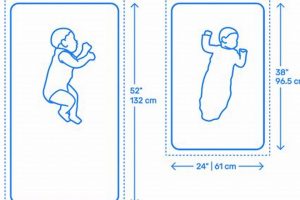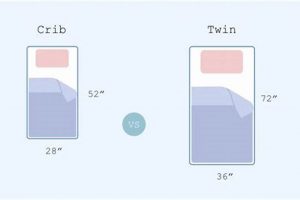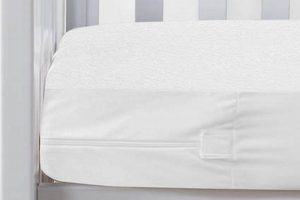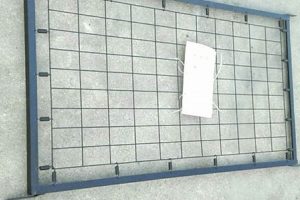A sleeping surface designed for infant beds featuring a water-impermeable layer intended to protect the core from spills, accidents, and other liquids. This layer is typically made of vinyl, polyurethane, or other waterproof materials. These specialized items are sized to fit standard-sized baby beds, providing a safe and hygienic sleep environment.
The benefit of this type of bedding lies in its ability to maintain cleanliness and hygiene, extending the lifespan of the core material. They prevent moisture buildup, which can lead to the growth of mold and bacteria. Historically, parents have used various methods to protect their baby’s sleep space, and the waterproof version represents a modern solution for managing potential messes and maintaining a sanitary area. The availability of such a product provides peace of mind for caregivers, ensuring a cleaner and potentially healthier rest for their child.
Further discussion will delve into the different materials used in construction, safety standards and certifications, cleaning and maintenance procedures, and factors to consider when selecting the appropriate model for an infant.
Essential Considerations for a Dry Infant Sleep Environment
Selecting the correct bedding for an infant’s bed is crucial for hygiene, safety, and longevity. The following tips offer guidance for choosing and maintaining a bed designed to resist liquid penetration.
Tip 1: Verify Safety Certifications: Ensure the product is certified by relevant safety organizations such as JPMA or Greenguard Gold. These certifications indicate that the item has been tested for chemical emissions and meets safety standards.
Tip 2: Assess Material Composition: Investigate the materials used in its construction, focusing on the waterproof layer. Phthalate-free vinyl or polyurethane options are preferred for reducing exposure to potentially harmful chemicals. Look for breathable waterproof materials to minimize the risk of overheating.
Tip 3: Evaluate Fit and Dimensions: Confirm that the bedding dimensions precisely match the internal dimensions of the bed frame. A snug fit is essential to prevent gaps where a baby could become entrapped.
Tip 4: Review Waterproofing Effectiveness: Examine product reviews and specifications to understand the degree of liquid resistance offered. Some models offer superior protection against leaks and spills.
Tip 5: Establish a Regular Cleaning Schedule: Implement a consistent cleaning routine to maintain hygiene. Wipe the surface regularly with a mild, non-toxic cleaner. Promptly address any spills to prevent staining or bacterial growth.
Tip 6: Use a Mattress Protector: Consider using a washable protector in addition to the built-in waterproof layer. This adds an extra layer of protection and simplifies cleaning procedures.
Tip 7: Inspect Regularly for Wear and Tear: Routinely inspect the surface for signs of cracks, tears, or deterioration. Replace the product if any damage is detected, as compromised waterproofing can lead to hygiene issues.
Choosing the right bedding and adhering to proper maintenance practices will significantly contribute to a cleaner and safer sleep environment for infants. Prioritizing safety certifications, material composition, and regular upkeep are key to maximizing its benefits.
The subsequent sections will cover advanced topics such as troubleshooting common issues, understanding warranties, and disposal methods.
1. Waterproof Layer Material
The waterproof layer constitutes a critical component of any infant bed designed to resist liquid penetration. The material selection directly influences the product’s performance, safety, and lifespan. A substandard waterproof layer renders the entire unit ineffective, exposing the inner core to moisture and potential contamination. For instance, if a thin, easily punctured vinyl is used, even minor incidents can compromise the mattress, leading to mold growth and bacterial proliferation within. Conversely, a durable, well-constructed waterproof layer effectively safeguards the core, extending its usable life and maintaining a hygienic sleep environment. Examples of suitable materials include polyurethane laminate (PUL) and certain grades of vinyl, provided they meet safety standards regarding chemical emissions.
The choice of material has significant implications for the childs health. Materials containing phthalates or volatile organic compounds (VOCs) can off-gas, potentially affecting infant respiratory systems. Therefore, materials certified by organizations like Greenguard Gold are preferable. Furthermore, the waterproof layer must balance impermeability with breathability. A completely impermeable layer can trap heat and moisture, increasing the risk of overheating and discomfort. The materials flexibility also matters; a stiff, inflexible layer can be uncomfortable for the infant and prone to cracking over time. Practical examples include the increasing adoption of TPU (Thermoplastic Polyurethane) due to its balance of waterproofing, flexibility, and reduced chemical content.
Understanding the properties and safety characteristics of the waterproof layer material is essential for informed decision-making. Challenges remain in balancing cost, durability, safety, and environmental impact. Ongoing research and development are focusing on creating more sustainable and effective waterproof materials that minimize health risks. Ultimately, the selection of the appropriate material is integral to the overall functionality and safety profile. A well-chosen waterproof layer guarantees a clean, dry, and safe sleep environment for infants.
2. Size and Fit
The proper dimensions and snug integration are paramount when considering bedding that repels liquids for infant use. Inadequate fit negates the protective and safety features integral to its design. The following points delineate the critical aspects of size and integration for this specialized product.
- Standard Dimensions Adherence
Regulation-sized infant beds in the US necessitate items sized to approximately 28 inches wide by 52 inches long. Deviations from these established measurements can introduce gaps between the mattress edge and the bed frame, posing an entrapment risk. A correctly sized mattress ensures a snug, gap-free fit, preventing potential hazards.
- Thickness Considerations
Beyond length and width, appropriate depth is crucial. A mattress that is excessively thick may compromise the bed’s railing height, increasing the risk of an infant climbing out. Conversely, an overly thin mattress may not provide adequate support. The ideal thickness should comply with safety guidelines and manufacturer specifications for the specific bed frame being used.
- Snugness of Fit Verification
A simple test to verify proper integration involves pressing firmly along the perimeter of the mattress. Minimal space should exist between the mattress and the bed frame. The ability to easily insert more than two fingers in this gap indicates an unacceptable fit. Regular checks are essential, particularly as the mattress settles with use.
- Impact on Waterproof Integrity
An improperly sized mattress can stretch or compress the waterproof layer, potentially compromising its integrity. Over-stretching can lead to tears or weakened seams, while compression can create areas where liquid pools. Maintaining correct dimensions ensures even distribution of weight and preserves the effectiveness of the liquid-resistant barrier.
The convergence of appropriate dimensions, thickness, and snug integration is pivotal for safety and performance. Prioritizing these factors guarantees the continued effectiveness of the liquid-resistant barrier and minimizes potential risks associated with inadequate fit. Regular assessment remains essential throughout the product’s usage.
3. Safety Certifications
The correlation between safety certifications and a bed designed to resist liquid penetration for infants is direct: certifications serve as verifiable indicators of product compliance with established safety standards. These standards address a range of potential hazards, including chemical emissions, flammability, and structural integrity. The absence of relevant safety certifications raises concerns regarding the product’s safety profile and its suitability for use by infants, who are particularly vulnerable to environmental toxins and physical hazards. A certification, such as GREENGUARD Gold, assures that the product has been tested and found to have low chemical emissions, minimizing the risk of respiratory irritation or other adverse health effects. Without such validation, claims regarding the absence of harmful substances are unsubstantiated.
Consider the case of an infant mattress lacking flammability certifications. In the event of a fire, this mattress could ignite more readily and release toxic fumes, increasing the risk of serious injury or death. Similarly, the absence of certifications related to structural integrity could result in a mattress that collapses or deteriorates rapidly, posing a suffocation or entrapment hazard. Real-world examples of product recalls underscore the importance of certifications; many recalls are initiated due to the discovery of non-compliant materials or manufacturing defects that could have been identified through rigorous testing procedures mandated by certification bodies. Therefore, these certifications act as a preventative measure, reducing the likelihood of product-related injuries or illnesses.
In summation, safety certifications provide tangible evidence of a manufacturer’s commitment to product safety and compliance with industry standards. These certifications are not merely symbolic; they represent a rigorous testing and evaluation process designed to mitigate potential risks to infant health and well-being. Consumers should prioritize products bearing relevant safety certifications, as they offer a greater degree of assurance that the mattress has been designed and manufactured with safety as a primary concern. Ignoring safety certifications represents an unnecessary and potentially dangerous gamble with an infant’s health and safety.
4. Cleaning protocol
Effective maintenance of a waterproof infant bed relies on stringent cleaning protocols. These procedures directly impact the product’s lifespan, hygiene, and the health of the infant. The cleaning protocol is not merely an afterthought but an integral component of a waterproof bedding system.
- Frequency of Cleaning
Regularity is paramount. Infrequent cleaning allows spills and accidents to permeate the surface, potentially fostering mold growth and bacterial proliferation. The bedding should be cleaned immediately after any incident and routinely, even in the absence of visible soiling, to maintain optimal hygiene. Example: A weekly wipe-down with a mild disinfectant is standard practice, supplemented by immediate cleaning after spills.
- Appropriate Cleaning Agents
The selection of cleaning agents is critical. Harsh chemicals can degrade the waterproof layer, compromising its integrity. Conversely, ineffective cleaning agents fail to eliminate harmful microorganisms. pH-neutral, non-toxic cleaners are recommended. Example: A solution of mild dish soap and water, or specialized infant-safe disinfectant wipes.
- Cleaning Technique
Proper application of cleaning agents is essential. Vigorous scrubbing can damage the waterproof layer, while inadequate application leaves contaminants behind. Gentle wiping with a soft cloth is the preferred method. The bedding must be thoroughly dried before use to prevent moisture buildup. Example: Using a damp cloth to gently wipe the surface, followed by air drying or wiping with a dry cloth.
- Disinfection Practices
In instances of contamination, simple cleaning may be insufficient. Disinfection protocols are necessary to eliminate pathogens effectively. However, disinfection agents must be carefully selected to avoid harming the infant or damaging the mattress. Example: Using a diluted bleach solution (as per CDC guidelines for surface disinfection) for thorough cleaning, followed by rinsing with clean water and thorough drying.
The confluence of cleaning frequency, agent selection, technique, and disinfection practices dictates the long-term efficacy and safety of waterproof bedding. Adhering to a well-defined and consistently executed cleaning protocol is not optional but a fundamental requirement for safeguarding infant health and maximizing product longevity.
5. Durability and longevity
The relationship between physical resistance and lifespan is of central importance when evaluating bedding for infants. The following analysis explores facets that directly influence the product’s ability to withstand wear and maintain its integrity over time.
- Material Composition and Construction
The constituent materials dictate the product’s ability to endure stresses associated with routine use. High-density foam cores, reinforced seams, and robust waterproof layers contribute significantly to extended life. Inadequate material selection results in premature sagging, seam failures, and compromised liquid resistance. Example: A mattress utilizing multi-layered construction with a tear-resistant outer layer will generally outlast a single-layer, low-density counterpart.
- Resistance to Liquid Penetration
The effectiveness of the waterproof layer directly correlates with the overall lifespan. Repeated exposure to liquids degrades the core material, fostering mold growth and diminishing structural support. Superior resistance safeguards the internal components, preserving the mattress’s form and function. Example: A waterproof layer incorporating welded seams and a tight weave will offer greater protection against leakage compared to a loosely woven, seamed alternative.
- Resistance to Wear and Tear
The product’s capacity to withstand physical abrasion and compression impacts its longevity. Constant pressure from an infant, coupled with routine handling during sheet changes, places significant stress on the surface. Durable materials and reinforced edges mitigate the effects of wear. Example: Mattresses with reinforced edges and abrasion-resistant surfaces demonstrate a greater ability to maintain their structural integrity and cosmetic appeal over time.
- Maintenance Practices
Adherence to prescribed cleaning and care protocols significantly influences lifespan. Improper cleaning agents or techniques can degrade the waterproof layer and compromise structural integrity. Regular cleaning and proper storage extend the product’s usability. Example: Utilizing harsh chemical cleaners can prematurely deteriorate the waterproof membrane, while consistently following manufacturer’s recommendations ensures prolonged performance.
These interlinked elements of composition, liquid resistance, wear resistance, and appropriate maintenance collectively determine the product’s overall lifespan. A focus on these aspects during the selection process enhances value by ensuring sustained performance and mitigating the costs associated with premature replacement. The longevity is a critical factor when evaluating long-term cost-effectiveness and safety.
6. Chemical Composition
The chemical makeup is a critical factor influencing the safety and suitability of any infant bedding product. The types of materials utilized and their potential to release volatile organic compounds (VOCs) or other harmful substances are primary concerns. These substances can off-gas into the infant’s sleep environment, potentially leading to respiratory irritation, allergic reactions, or other adverse health effects. The waterproof layer, often composed of vinyl or polyurethane, is particularly relevant due to its proximity to the infant. Inferior-quality materials may contain phthalates, known endocrine disruptors, or other chemicals restricted in children’s products. A bed designed to resist liquid penetration that fails to meet stringent chemical safety standards presents a direct health risk.
Examples of concerning chemicals include formaldehyde, often found in adhesives used in the mattress core, and flame retardants, historically incorporated to meet flammability standards. While flame retardants may reduce the risk of fire, some types have been linked to neurodevelopmental problems and other health issues. A practical example is the increasing consumer demand for products certified to Oeko-Tex Standard 100 or GREENGUARD Gold, which independently verify low chemical emissions. Manufacturers are responding by using materials such as plant-based foams, organic cotton, and water-based adhesives to reduce their reliance on potentially harmful chemicals. Understanding the chemical composition also informs maintenance practices. Aggressive cleaning agents may react with the waterproof layer, causing it to degrade and potentially release harmful substances.
Ultimately, the careful selection of chemically safe materials and adherence to established safety standards is paramount. The challenge lies in balancing waterproofing effectiveness, durability, and affordability with the need to minimize chemical exposure. Continued research and development are essential to identify and implement safer alternatives. The practical significance of understanding chemical composition lies in its ability to empower consumers to make informed choices that prioritize the health and well-being of infants. Choosing a product with transparent chemical information represents a crucial step in creating a healthier sleep environment.
7. Breathability
The characteristic of breathability assumes critical importance in the context of bedding for infants. Waterproofing, while essential for hygiene and protection, inherently limits air circulation. This reduction in airflow can elevate the risk of overheating, a significant concern for newborns and young infants who lack fully developed thermoregulatory capabilities. The materials used in a waterproof core must therefore strike a delicate balance between impermeability and the ability to dissipate heat and moisture. If the materials trap heat, an infant’s body temperature can rise to dangerous levels, potentially contributing to Sudden Infant Death Syndrome (SIDS) or other heat-related illnesses. This necessitates the incorporation of breathable components within the construction, mitigating the negative consequences of a waterproof barrier. For example, using a waterproof layer composed of a breathable polyurethane laminate (PUL) allows for vapor transmission while preventing liquid penetration.
The selection of appropriate materials and construction techniques directly affects the breathability of the item. Waterproof layers often feature micro-pores or specialized membranes that permit the passage of air and moisture vapor. In practical application, a non-breathable mattress will exhibit a noticeable increase in surface temperature during prolonged use, whereas a breathable model will maintain a more stable and comfortable temperature. This difference can be quantified through thermal imaging or simple temperature measurements. The integration of breathable fabrics, such as organic cotton or bamboo, in the mattress cover further enhances airflow. Parents are increasingly seeking mattresses with certifications, such as those from CertiPUR-US or OEKO-TEX, which guarantee that the materials used are not only low in chemical emissions but also promote breathability and overall safety.
The interplay between waterproofing and breathability represents a central challenge in the design and manufacture of bedding for infants. While effective liquid resistance is crucial for maintaining hygiene and preventing damage, compromising airflow can introduce significant health risks. Continuous innovation in material science is focused on developing waterproof barriers that allow for sufficient ventilation, thereby minimizing the risk of overheating and promoting a safe and comfortable sleep environment. Prioritizing products that demonstrably balance these two essential attributes is paramount for safeguarding infant health and well-being.
Frequently Asked Questions
This section addresses common inquiries concerning infant bedding designed to resist liquid penetration, providing clarity on essential aspects of safety, functionality, and maintenance.
Question 1: What are the primary safety certifications to look for when purchasing a waterproof infant sleeping surface?
Established certifications such as GREENGUARD Gold and CertiPUR-US indicate that the product has undergone testing for chemical emissions and material content. These certifications offer assurance that the product meets specific safety standards.
Question 2: How often should infant bedding designed to resist liquid penetration be cleaned?
Routine cleaning is essential. The surface should be cleaned immediately following any spills or accidents. Regular cleaning, even in the absence of visible soiling, is also recommended to maintain a hygienic sleep environment.
Question 3: What types of cleaning agents are appropriate for cleaning infant bedding with a waterproof layer?
Mild, pH-neutral, and non-toxic cleaning agents are recommended. Harsh chemicals can degrade the waterproof layer, compromising its integrity. Cleaning agents specifically designed for infant products are generally preferred.
Question 4: Is breathability a concern with a waterproof infant sleeping surface?
Breathability is a significant consideration. Waterproof materials can restrict airflow, potentially leading to overheating. Look for models that incorporate breathable materials or designs to mitigate this risk.
Question 5: What materials are commonly used for the waterproof layer, and are there any specific materials to avoid?
Common materials include vinyl and polyurethane. Phthalate-free vinyl and breathable polyurethane laminates are generally preferred. Materials containing known harmful chemicals should be avoided.
Question 6: How does the fit of bedding with liquid-resistant properties impact safety?
Proper fit is crucial. A snug fit is essential to prevent gaps between the bedding and the bed frame, which can pose an entrapment hazard. The dimensions should precisely match the interior dimensions of the bed frame.
Understanding these factors empowers informed purchasing decisions and ensures the safety and well-being of infants.
The subsequent section will provide a comparative analysis of available product types, offering guidance on selecting the most suitable option.
crib waterproof mattress
The preceding examination has scrutinized various critical aspects of the specialized infant bedding. Dimensions, chemical composition, breathability, cleaning protocols, durability, and safety certifications comprise an interconnected framework essential for its selection and maintenance. The capacity to resist liquid penetration remains the core functional requirement; however, manufacturers and caregivers must recognize that this capability should never compromise safety or infant well-being. Rigorous adherence to established standards, coupled with informed purchasing decisions, is paramount.
The selection and utilization of a product within this category represent a commitment to the health and safety of the infant. Ongoing vigilance in monitoring the product’s condition, adherence to appropriate cleaning protocols, and a thorough understanding of relevant safety guidelines are non-negotiable responsibilities. The future of this product category hinges upon continued innovation in material science and manufacturing processes, with an unwavering focus on minimizing potential risks and maximizing the benefits for infant care.


![Choosing the Right Short Crib Mattress [Guide] Organic & Natural Mattress Buyer’s Guide: Non-Toxic Sleep Solutions Choosing the Right Short Crib Mattress [Guide] | Organic & Natural Mattress Buyer’s Guide: Non-Toxic Sleep Solutions](https://mattressworldpa.com/wp-content/uploads/2025/07/th-1280-300x200.jpg)



![Lullaby Earth Crib Mattress: Safe, Certified [Sleep] Organic & Natural Mattress Buyer’s Guide: Non-Toxic Sleep Solutions Lullaby Earth Crib Mattress: Safe, Certified [Sleep] | Organic & Natural Mattress Buyer’s Guide: Non-Toxic Sleep Solutions](https://mattressworldpa.com/wp-content/uploads/2025/07/th-1276-300x200.jpg)
